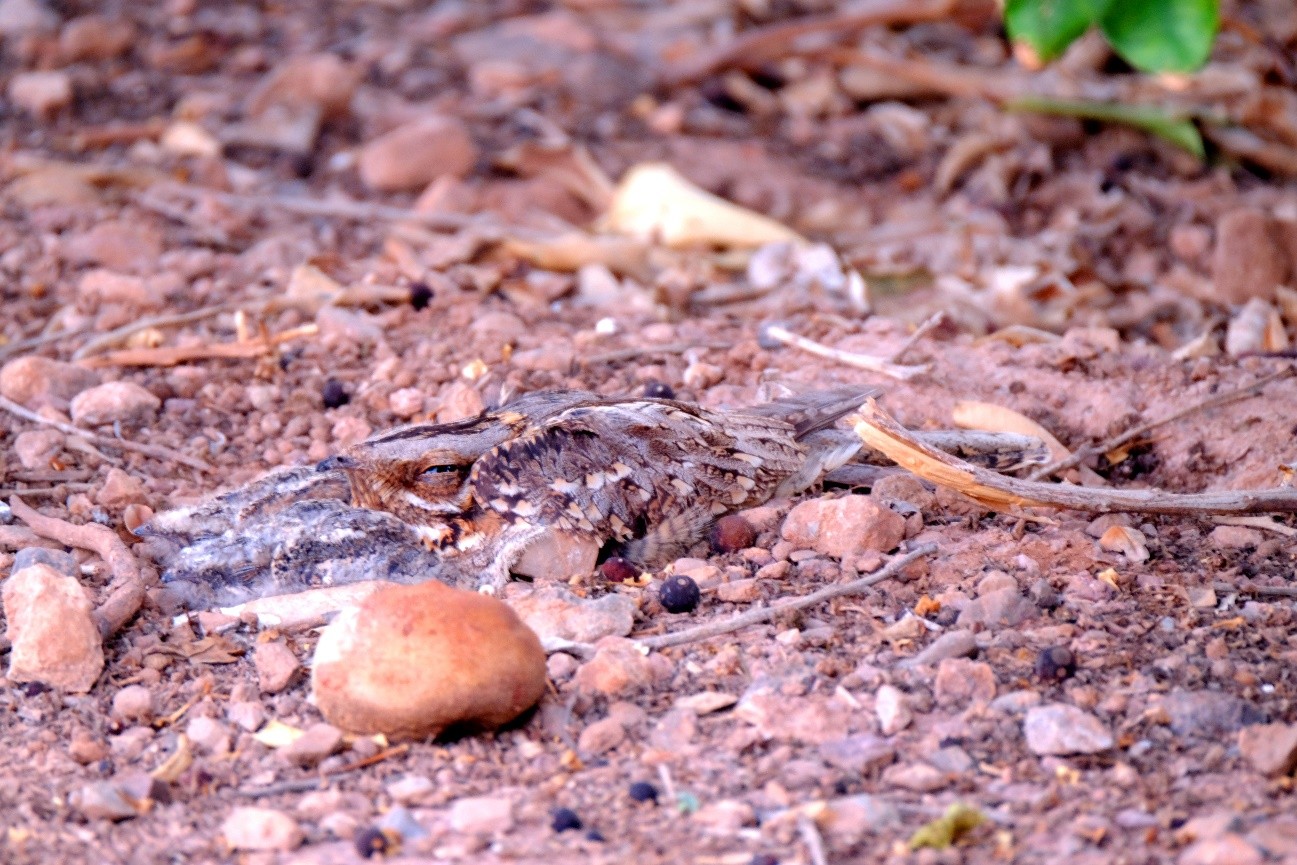Insectivorous birds in intensive farmland adapt their foraging behavior to breed successfully

Female red-necked nightjar (Caprimulgus ruficollis) tending to her two chicks beneath a citrus tree in one of the agricultural sites studied. Source: Proyecto Chotacabras
A team of researchers from several Spanish institutions, led by the Miguel Hernández University and in collaboration with the Doñana Biological Station (CSIC), has spent four years studying the breeding behavior of the red-necked nightjar (Caprimulgus ruficollis) in two neighboring citrus farms in the heart of Spain’s Murcia region. Although the two farms lie side by side, one is managed using intensive farming practices—including frequent pesticide application—while the other follows organic farming methods.
Surprisingly, the nightjars breeding in both farms showed similar reproductive success. However, those in the intensively farmed site had to adapt their foraging behavior in order to breed successfully, frequently flying several kilometers away from their nests in search of food. In contrast, birds in the organic farm foraged more often within the property itself, benefitting from a greater availability of natural habitat patches rich in moths, their primary prey.
Over recent decades, intensive agriculture has expanded globally in response to rising food demands driven by human population growth. Unlike organic farming, intensive practices typically involve the heavy use of chemical fertilizers and pesticides, which has contributed to the widespread decline of farmland birds—especially insectivorous species. Organic farming, by contrast, relies on biological pest control, reducing environmental pollution and helping preserve biodiversity.
The value of long-term field studies
“The remarkable ability of nightjars to camouflage their nests has long posed a challenge for researchers studying their breeding biology. Only a handful of studies have located enough nests to draw robust conclusions,” explains José Manuel Zamora Marín, lead author of the study.
Over the four-year period, the research team located and monitored 191 nightjar nests across both farms. For each nest, they recorded four key reproductive metrics: clutch size, hatching rate, fledging success, and overall reproductive success. They also gathered data on laying dates (breeding phenology), age structure of the breeding population, and breeding pair density in each farm. Additionally, 31 breeding adults were fitted with GPS tracking devices, allowing researchers to identify foraging areas and estimate home range sizes.
Overall, the population showed moderate reproductive success, comparable to that seen in vineyards and more traditional agricultural landscapes of the Iberian Peninsula. Notably, the birds in both farm types exhibited similar breeding phenology, age structure, and reproductive metrics. However, GPS data revealed that nightjars in the intensively managed farm traveled farther—2 to 8 kilometers from their nests—to forage, while those in the organic farm typically foraged within the farm itself.
The role of heterogeneous agricultural landscapes
The findings highlight the importance of promoting heterogeneous, mosaic-like agricultural landscapes to help offset the biodiversity impacts of intensive farming. The authors emphasize the need to incorporate landscape features such as hedgerows, small water bodies, fallow land, and patches of natural vegetation. These elements can provide alternative foraging habitats for birds and improve connectivity between nesting and feeding sites.
Such measures could support healthy populations of insectivorous birds, which in turn can act as natural pest controllers—offering ecological and agricultural benefits alike.
The study has been published in Ecological Applications and was conducted by researchers from Miguel Hernández University (UMH), the Doñana Biological Station (EBD-CSIC), the Southeast Naturalists’ Association (ANSE), the Ulula Association, and the Autonomous University of Madrid (UAM), with the support of the agricultural company Explotaciones Agrícolas de la Región de Murcia (EARMUR SL).
Reference
José M. Zamora-Marín, Antonio Zamora-López, Mario León-Ortega, Pedro Sáez-Gómez, Francisco A. García-Castellanos, José A. Sánchez-Zapata, Carlos Camacho. Breeding performance of an aerial insectivorous bird under contrasting farming systems. Ecological Applications. Doi: https://doi.org/10.1002/eap.70059